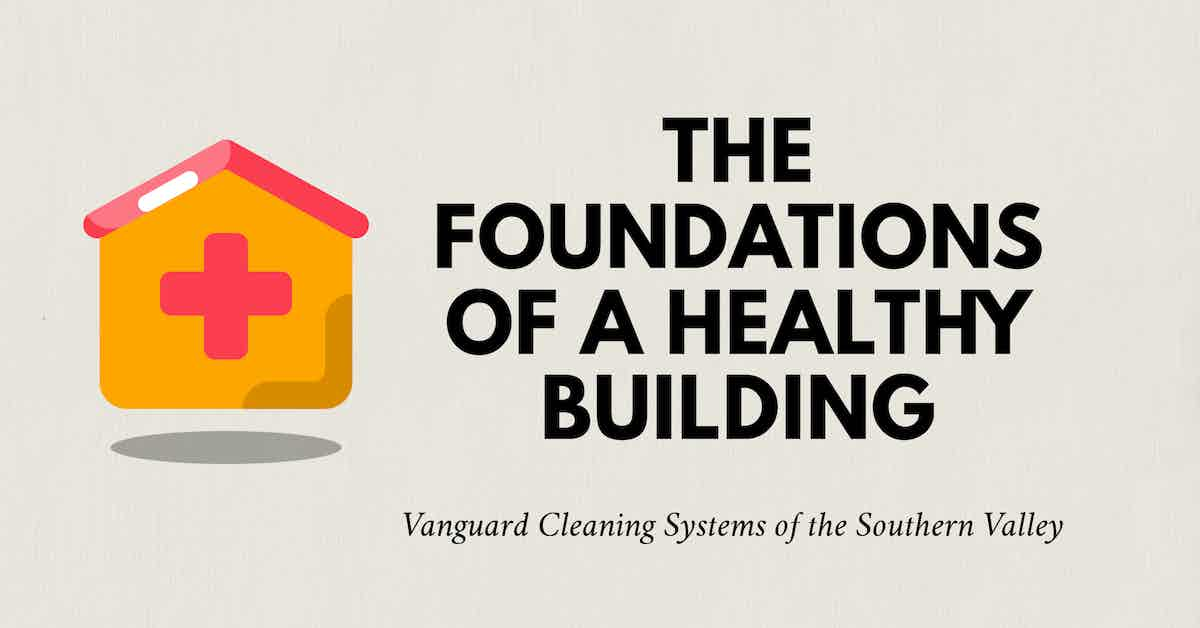Researchers have identified nine areas of a facility's daily operations critical to maintaining healthy and productive schools and businesses.

The 9 Foundations of a Healthy Building
A team of researchers from Harvard University, working in conjunction with experts across relevant fields, including real estate, facilities management, and academia, have identified nine fundamental characteristics of a healthy building:
- Ventilation.
- Air quality.
- Thermal health.
- Moisture.
- Dust & pests.
- Safety & security.
- Water quality.
- Noise.
- Lighting & views.
What Makes A Building Healthy?
A healthy building contributes to the overall health and wellness of the occupants.
- The air and water are clean, safe, and free of toxins.
- Indoor air quality, temperatures, and humidity levels are monitored and controlled.
- The building is free of pests.
- Work areas are monitored for and kept free of dust, germs, and bacteria.
- Indoor and outdoor noise levels are controlled.
- Windows provide generous outdoor views and substantial sunlight, and;
- The occupants are physically safe and secure from outside threats and indoor pollutants.
Additionally, several elements are commonly integrated into the design of the building and the layout of the office space that aid in maintaining long-term building health.
According to Digital School;
There are several key elements to making a building healthy.
With regards to ventilation, for example, it’s suggested that outdoor air ventilation guidelines be met or exceeded and that air intakes on the exterior of a building be placed away from street-level pollutants.
In order to maintain good quality, materials with low chemical emissions should be used and humidity should be kept between 30%-60% to reduce odor issues.
When it comes to lighting and views, all workstations should have a direct sightline to an exterior window, and as much daylight as possible should be allowed inside.
What Makes a Building ‘Healthy’ and How Do Architects Design Them?
Why Healthy Buildings Matter
In addition to the benefits afforded to occupants by living, working, shopping, and learning in safer, cleaner buildings, healthy buildings also provide substantial financial incentives for facility and business owners.
According to researchers from UL;
A healthy building with good IEQ can affect changes to cognitive function and quality of life.
In the “CogFX Study” by the Harvard T.H. Chan School of Public Health’s Center for Health and the Global Environment, researchers identified that characteristics like ventilation, indoor pollutants, lighting, daylight, and views were shown to affect health, quality of life, focus and productivity (2015).
The study, published in Environmental Health Perspectives, tested the difference between conventional buildings that have been built with products that emit higher levels of volatile organic compounds (VOCs), green buildings designed to have lower VOCs, and enhanced green buildings with low VOCs and low carbon dioxide, mimicking additional ventilation.
Buildings that were characterized as enhanced green buildings improved participants’ abilities to strategize, respond to crises, focus and remain task oriented.
Further;
[...] participants in certified green, high-performing buildings also slept better at home, even after they left the building they were working in.
Employees in buildings with a better IEQ increased their productivity at an average of making $6,500 more per year.
Clearly, enhancing the quality of a building improves the lives of employees and forwards the overall success of any business.
Health and Wellness in Buildings: Addressing Challenges Now and in the Future
References & Resources
Takeaway
Current research demonstrates that healthy buildings are seen as assets by investors and business owners for their critical role in contributing to highly productive and profitable workplaces.
According to a study conducted by the MIT Real Estate Innovation Lab;
We find that healthy building effective rents transact between 4.4 and 7.7% more per square foot than their nearby noncertified and non-registered peers.
This premium for healthy spaces is independent of all other factors, such as LEED certification, building age, renovation, lease duration, and submarket.
These results indicate that healthy buildings are seen as an asset that correlates with employee or tenant well-being and productivity.
Focusing on improvements to indoor air quality is the most efficient and effective investment of resources, particularly for smaller organizations seeking to maximize their return quickly.
This can be accomplished by:
- Switching to green cleaning products.
- Increasing cleaning frequencies.
- Implementing targeted disinfection services.
- Upgrading to microfiber and;
- Using commercial-grade HEPA-filtered vacuums to clean the floors at least once daily.
Onboarding and managing the requisite labor and material resources necessary to ensure the highest standards of cleanliness are achieved and maintained may prove cost-prohibitive for many organizations.
Outsourcing is a proven method for onboarding highly in-demand cleaning and disinfection services and experience for a fraction of the price of maintaining a similar service in-house.
If you would like more information regarding the effectiveness of high-performance infection prevention and control measures, or if you would like to schedule a free, no-obligation on-site assessment of your facility's custodial needs, contact us today for a free quote!
In Bakersfield, CA, call (661) 437-3253
In Fresno, CA, call (559) 206-1059
In Valencia, CA, or Santa Clarita, CA, call (661) 437-3253
In Palmdale, CA, or Lancaster, CA, call (661) 371-4756

